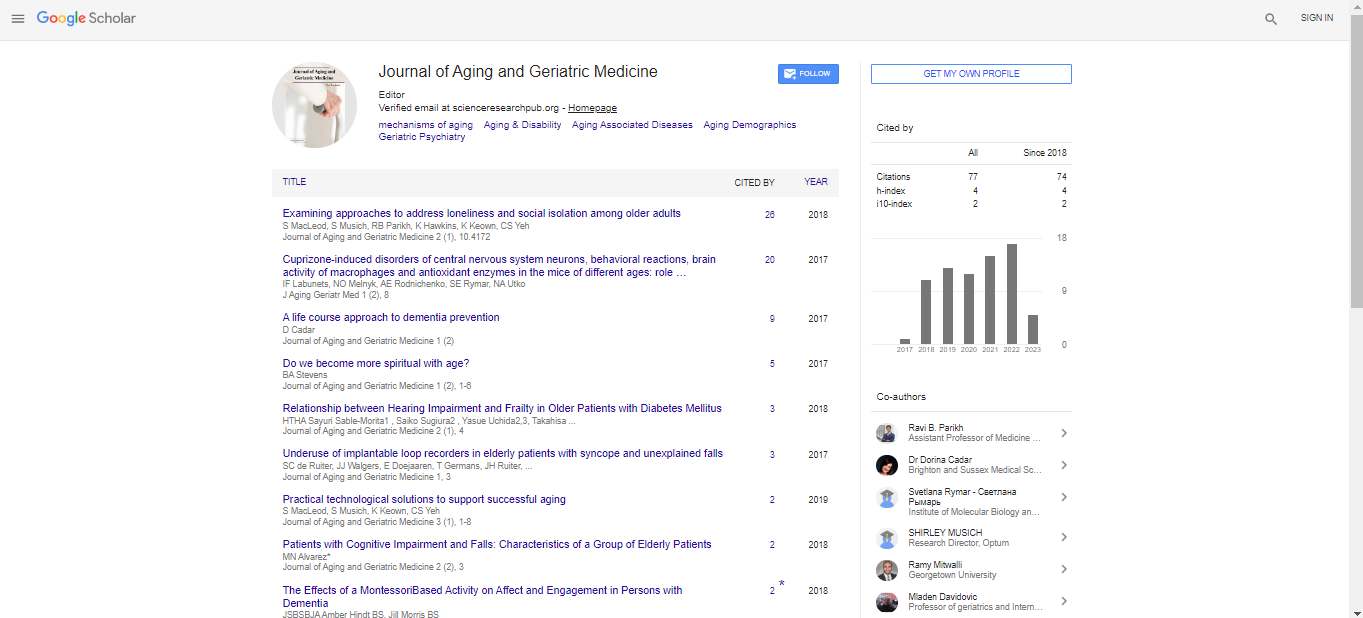Short Communication, J Aging Geriatr Med Vol: 7 Issue: 4
Parkinson's Disease: Mapping the Pathways to a Cure in the Genomic Era
Lawence Worth*
1Department of Neurosciences, University of California, San Diego, United States of America
*Corresponding Author: Lawence Worth,
Department of Neurosciences, University
of California, San Diego, United States of America
E-mail: worthlnuc@ucl.edu
Received date: 28 June, 2023, Manuscript No. AGM-23-113309;
Editor assigned date: 30 June, 2023, PreQC No. AGM-23-113309 (PQ);
Reviewed date: 14 July, 2023, QC No. AGM-23-113309;
Revised date: 21 July, 2023, Manuscript No. AGM-23-113309 (R);
Published date: 28 July, 2023, DOI: 10.4172/2576-3946.1000167
Citation: Worth L (2023) Parkinson's Disease: Mapping the Pathways to a Cure in the Genomic Era. J Aging Geriatr Med 7:4.
Description
Parkinson's disease is a neurodegenerative disorder that primarily impairs movement, but it can also lead to a range of other symptoms. While traditional treatments such as medication and physical therapy have been the mainstays of care, recent years have witnessed exciting developments in the field, with a focus on innovative therapies and technologies [1]. Parkinson's disease was first described by James Parkinson in 1817 and has since become a subject of extensive research and clinical investigation. It primarily affects individuals over the age of 60, but early-onset cases can occur. This disorder is characterized by the gradual loss of dopamine-producing neurons in the brain [2]. Dopamine is a neurotransmitter that plays a crucial role in controlling movement, and its deficiency leads to the hallmark motor symptoms of Parkinson's disease.
Causes and symptoms
The exact cause of Parkinson's disease remains unknown, but researchers believe that it results from a combination of genetic and environmental factors [3]. Mutations in certain genes have been linked to an increased risk of developing the condition. Additionally, exposure to environmental toxins such as pesticides and herbicides may contribute to its development. Symptoms include tremors, bradykinesia, and muscle rigidity, postural instability etc [4]. In addition to these motor symptoms, individuals with Parkinson's disease may also experience non-motor symptoms like depression, anxiety, sleep disturbances, and cognitive impairment.
Diagnosis and treatment
Physicians typically rely on a combination of medical history, physical examination, and neurological assessments to make a diagnosis. Imaging techniques like MRI and PET scans can help rule out other conditions with similar symptoms [5,6]. The primary treatment approach involves medications that increase dopamine levels in the brain, such as Levodopa. Physical therapy and exercise programs can also help maintain mobility and reduce muscle stiffness.
Emerging therapies
Gene therapy: One of the most promising areas of research involves gene therapy. Scientists are exploring ways to introduce genes that promote dopamine production into the brains of individuals with Parkinson's disease [7,8]. Stem cell therapy holds tremendous potential for Parkinson's disease treatment. Researchers are investigating the transplantation of dopamine-producing stem cells into the brains of patients to replace the damaged neurons.
Immunotherapy: Immunotherapy approaches are being explored to target the underlying causes of Parkinson's disease, such as misfolded proteins like alpha-synuclein. These therapies aim to modulate the immune system to prevent or slow the disease's progression [9].
Wearable devices: The development of wearable devices, like smartwatches and specialized sensors, has revolutionized the monitoring of Parkinson's disease symptoms. These devices can provide continuous data on movement and tremors, helping doctors adjust treatment plans more effectively.
Telemedicine: Telemedicine has become increasingly important, especially in the context of the COVID-19 pandemic [10]. It allows patients with Parkinson's disease to receive remote consultations and monitoring, ensuring continuity of care.
Conclusion
Parkinson's disease is a complex neurological disorder that continues to challenge researchers and clinicians alike. While there is no cure, ongoing research is focused on better understanding its causes and developing innovative therapies to improve the lives of those affected. Early diagnosis and appropriate management can significantly enhance the quality of life for individuals living with Parkinson's disease.
References
- Bloem BR, Okun MS, Klein C. (2021) Parkinson’s disease. The Lancet 397(10291):2284-303.
- KaliaLV,LangAE.(2015)Parkinson'sdisease.TheLancet386(9996):896-912.
- Samii A, Nutt JG, Ransom BR. (2004) Parkinson's disease. The Lancet363 (9423):1783-93.
- Lees AJ, Hardy J, Revesz T. (2009)Parkinson's disease. The Lancet 373(9680):2055-66.
- Marsden CD. (1994)Parkinson's disease. Journal of Neurology, Neurosurgery, and Psychiatry 57(6):672.
- Tolosa E, Wenning G, Poewe W. (2006) The diagnosis of Parkinson's disease. The Lancet Neurology 5(1):75-86.
- Cummings JL. (1992) Depression and Parkinson's disease: a review. The American journal of psychiatry149 (4):443-54.
- Schapira AH. (1999) Parkinson's disease. Bmj 318(7179):311-4.
- Davie CA. (2008)A review of Parkinson's disease. British medical bulletin. 86(1):109-27.
- De Lau LM, Breteler MM. (2006)Epidemiology of Parkinson's disease. The Lancet Neurology 5(6):525-35.
 Spanish
Spanish  Chinese
Chinese  Russian
Russian  German
German  French
French  Japanese
Japanese  Portuguese
Portuguese  Hindi
Hindi 